I don’t normally write about pitchers because I don’t have an eye for diagnosing approach like Nick Pollack or Shelly Verougstraete. In my opinion, it’s much easier to derive conclusions from data and lump hitters into categories (e.g., slugger, slap hitter, contact hitter) than it is to figure out a pitcher. One reason why is that there are many more approaches to pitching than there are to hitting. Pitching is an art, and I’m not a creative-type.
I do, however, like to fool around with the Statcast leaderboards on occasion. One such leaderboard lists Atlanta Braves starting pitcher Max Fried as having the best contact management skills in baseball, sitting pretty with the lowest barrel rate in the league. That struck me as odd given how Fried has given up quite a few home runs this season.
As such, I decided to explore this further and use it as an opportunity to test my hand at dissecting a pitcher. Without further hesitation, let’s head down South and dive deep into Fried’s 2019 season.
Fried Out Of Luck
Fried’s season has been a mixed bag. His 4.03 ERA isn’t really moving the needle for you, but some of his ERA indicators are more auspicious (3.79 FIP, 3.47 xFIP). His 10.8% swinging-strike rate and 16.7 K-BB% are above average but not reflective of his prospect pedigree. At 25 years old, he’s not exactly the youngest guy on the field anymore either, so I’m sure the Braves were expecting a little better of their southpaw prospect too.
Still, as I alluded to earlier, Fried’s got some interesting contact-management skills. The contact that he allows is generally of the low launch angle variety.
| GB% | LD% | FB% | PU% | |
| Max Fried | 53.6 | 26.7 | 17.0 | 1.8 |
| MLB Average | 45.5 | 25.5 | 22.0 | 7.1 |
Fried gives up far more ground balls than the average pitcher, and a few more line drives too. He’s especially adept at keeping the ball low, as his 3.5-degree average launch angle is the fourth-lowest among pitchers with 200 batted-ball events, behind only Dallas Keuchel, Dakota Hudson, and Chad Bettis. Giving up so many low launch angle balls in play has ceded a .345 BABIP, which is unsurprising considering that line drives and ground balls are far more likely to become hits than fly balls and pop-ups, the latter of which he almost never generates.
While Fried’s .345 BABIP is not far out of line with his .340 career BABIP, he nonetheless has been the victim of bad luck. Among all 130 pitchers who have faced 350 hitters, he has the sixth-biggest wOBA-xwOBA differential of 0.029, the seventh-biggest BA-xBA differential of 0.027, and the 11th-biggest SLG-xSLG differential of 0.060.
But Fried’s bad luck doesn’t stop there. Here’s how he ranks among all 151 pitchers with at least 200 BBEs in certain Statcast power metrics:
| Brls/PA% | Brls/BBE% | Hard Hit% | EV on FB/LD | EV on GB | Average Launch Angle | Average hit distance | Average HR distance | |
| Max Fried | 2.6 | 3.7 | 39.4 | 92.0 mph | 85.9 mph | 3.5° | 147 ft | 391 ft |
| MLB Rank (200 BBEs) | 1st | 1st | 108th | 34th | 116th | 4th | 11th | 15th |
Fried has the lowest barrel rates in baseball and one of the lowest average launch angles. He does give up quite a bit of hard contact, as evidenced by his hard-hit rate, but it’s most frequently on ground balls. Indeed, his average exit velocity on flies and liners is quite low relative to the league. As a result, his average hit distance is low because he’s mostly giving up hard ground balls and soft flies and liners. Likewise, his average home run distance is low as well. This all yields a low barrel rate, and one would, accordingly, expect a low home run rate.
Nevertheless, on the few fly balls he has given up, Fried’s been saddled with a poor 19.1 HR/FB% this season, allowing a whopping 19 homers to date. Amazingly, nine of his 17 home runs have been hit shorter than 400 feet, such as this one for 346 feet:
https://gfycat.com/gracefuldescriptiveicelandichorse
And this one that went a grand total of 352 feet:
https://gfycat.com/decimaljoyousflamingo
Or this 359-foot “blast” off the bat of noted powerhouse Melky Cabrera:
https://gfycat.com/seriousnippybanteng
I’m not suggesting he didn’t “earn” those specific home runs. All pitchers give up a few cheap ones. But some of this bad luck should regress given his incredibly low barrel rates and exit velocity on flies and liners. That last one was actually a decent pitch too. While Fried has been unlucky by several metrics, it’s important to examine Fried’s arsenal to see what else could be driving his mediocre 2019 campaign.
Four-seam Fastball
Fried’s primary pitch is a four-seam fastball, which has had mixed results:
| Usage | pVAL | SwStr% | O-Swing% | Zone% | Velo |
| 56.8% | -3.0 | 8.1% | 23.9% | 55.5% | 93.9 mph |
Of course, as this is a fastball, Fried throws it in the zone the majority of the time, so it’s no surprise it doesn’t generate more swings off the plate or swinging strikes in general. In fact, an 8.1% swinging-strike rate is fine considering the pitch type, and throwing 94 mph from the left side is pretty good.
Sometimes, he uses the pitch to climb the ladder, with great results.
https://gfycat.com/scientificzealousalpineroadguidetigerbeetle
If Fried could do that consistently, his fastball would be an excellent weapon. Instead, it’s sitting on a -3.0 pVAL. The reason? Poor command. Me saying that in the abstract is meaningless though, so take a look at an elite pitcher’s fastball plot to see what I mean.
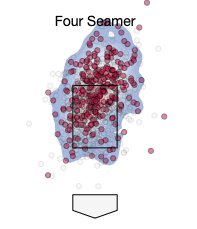
That’s Blake Snell’s 2019 two-strike plot for his four-seam fastball. He emphasizes featuring the pitch in the top of the zone regularly. But here’s Fried’s:
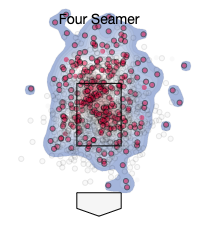
Fried’s fastball is all over the place when pitching with two strikes. Nick Pollack likes to say that there are three levels of fastball command. I’d put Fried in the second level. He plans to go up with his fastball with two strikes, and he can jam both righties and lefties with the pitch, but he just doesn’t always execute. While his four-seamer accounts for about 57% of his pitches thrown, it also accounts for an outsized portion of the damage done against him. Here are his pitch types for all hits against him:
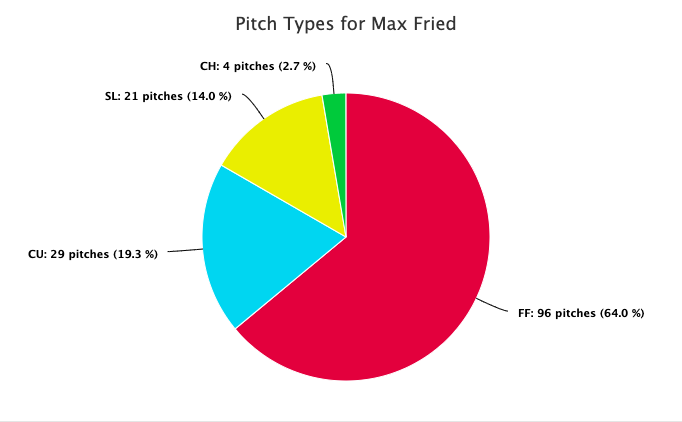
And it’s not just balls in play, either, as 10 of the 17 homers hit off of Fried have come on the four-seam fastball. Remember that homer he gave up to JT Realmuto?
https://gfycat.com/decimaljoyousflamingo
Fried completely missed his spot. The catcher is set up away, but Fried’s fastball runs over the middle of the plate. You can’t make mistakes like that with a 92 mph fastball. Similarly, Fried pitched a dud against the Mets the other night, but it was actually going alright until this happened:
https://gfycat.com/skinnyvengefulafricancivet
This time, his catcher is set up to bust Pete Alonso up and in, but Fried’s fastball leaked out over the plate once again.
Fried’s throwing his four-seamer 93.9 mph on average, which is pretty good but not good enough to blow by hitters when he misses his spot. Hung four-seamers are part of what gives him that ugly .345 BABIP, as the BABIP on the pitch alone is .375 and the batting average on the pitch is .339. Still, were this Fried’s only flaw, he could likely overcome it with excellent secondary pitches.
Curveball
Fried’s curveball is his bread and butter, rating out with a 70 future value from scouts.
| Usage | pVAL | SwStr% | O-Swing% | Zone% | Velocity |
| 25.5% | 0.9 | 14.3% | 35.7% | 37.2% | 74.6 mph |
This pitch should be better. Yet, it has only accumulated 0.9 pVAL over the course of the entire season. Nick talks about Money Pitches, or those that can be thrown in the zone for strikes, off the plate to generate swings, and are so deceptive that they create swings and misses no matter where they are thrown. An ideal secondary pitch fits this mold. But this pitch doesn’t meet a single one of those criteria.
https://gfycat.com/secretjoyfulesok
Still, when Fried’s right, he has one of the best curveballs in the entire league. His slow curve gets the seventh-most vertical movement vs. the average. So Fried’s at his best when he can not only manage contact—which he does at an elite level—but also when he tunnels his curveball with his fastball to fool batters to swing over the top.
The problem is he isn’t always right, which is why his curveball doesn’t meet the Money Pitch criteria. Put differently, he struggles with the command of his curveball too.
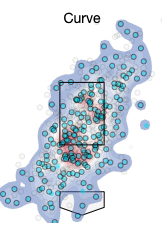
This is Fried’s curveball plot with two strikes. There should be a focus at the bottom of the zone, but Fried isn’t able to consistently locate there, wasting a large number of curves either in the zone or above it. Again, for comparative purposes, here’s two-strike Snell:
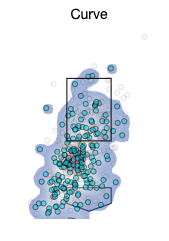
Fried himself realizes this is a problem as, having struggled with his command lately, he eschewed the curve for a slider he developed this season. In two of his past four games, he has turned to his slider more than his curve. Unfortunately, in those four starts, Fried’s lasted six innings just once, with a below-average 28.3% blended CSW rate.
Part of this is the result of poorly located fastballs. But another reason is poorly located curves. He can effectively use the curve to steal strikes early in the count, but he also needs to be able to use it as a putaway pitch, and lately, he’s been ineffective doing so.
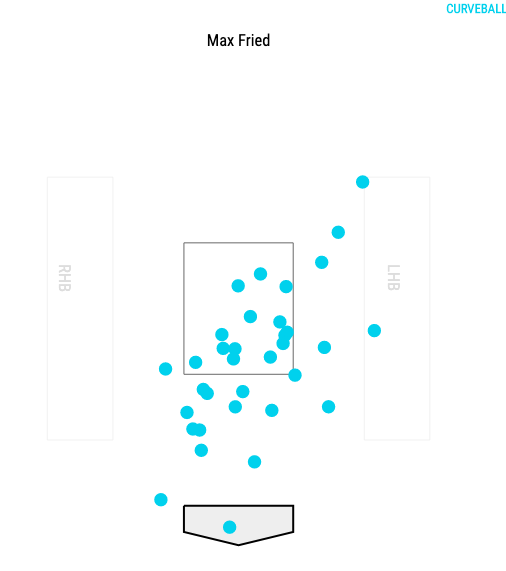
This is what he’s done in the past four games when ahead in the count. There’s no pattern here when it should be fairly obvious. Unsurprisingly, by pVAL, his curve graded out as -0.3, -0.3, -0.7, and -1.3 in those starts. He had a similar five-start stretch in June in which he could not locate the pitch when ahead in the count, and it similarly graded out negatively in each outing.
By comparison, Snell lands his curveballs at the bottom of or below the zone when ahead in the count. The contrast is stark, and when Fried fails to put away batters with his curve, he becomes more reliant on his fastball, which explains in part the poor results on that pitch as well. He can’t create an effective tunnel when his curves are landing up in the zone, and he has to rely on his fastball as an out pitch.
Sometimes, he just hangs his curve even though he’s trying to locate it below the zone.
https://gfycat.com/carelessnearcaiman
Again, his catcher flashes his glove at the bottom of the zone, but the pitch just hangs up for Jeff McNeil to crush.
https://gfycat.com/scaryimperturbableeskimodog
Other times, the pitch is just completely wasted, such as here when he hits intimidating slugger Zack Wheeler. At bottom, there’s a serious issue with the command of the pitch that made Fried an exciting prospect in the first instance.
Slider
It’s no wonder, then, that Fried has turned to his slider more lately.
| Usage | pVAL | SwStr% | Zone% | O-Swing | Velocity |
| 15.1% | 5.4 | 15.1% | 43.6% | 41.6% | 83.8 mph |
Now there’s a Money Pitch. Indeed, it has a swinging-strike rate over 15% and better than 40% Zone and O-Swing rates. As a result, Fried’s accumulated a 5.4 pVAL on this breaking ball, making it better than the pitch that garnered him notoriety in the first place. That usage rate is only increasing too as he’s gone to the slider 19.2% of the time in his past four starts.
https://gfycat.com/gracefulnaturalboilweevil
Fried’s slider is downright nasty when he dots the bottom corner of the zone either inside to righties or low and away to lefties. And with two strikes, he executes this pitch far more effectively than he can get chases with his curveball:
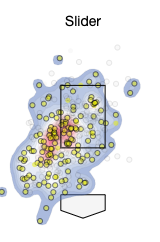
You can see a clearer approach with this pitch relative to the curveball. The advent of his slider this season has given Fried an excellent weapon to turn to when he has no feel for his curveball. Indeed, in the past four games when he’s struggled with the curve, here’s what he’s done when pitching ahead with the slider:
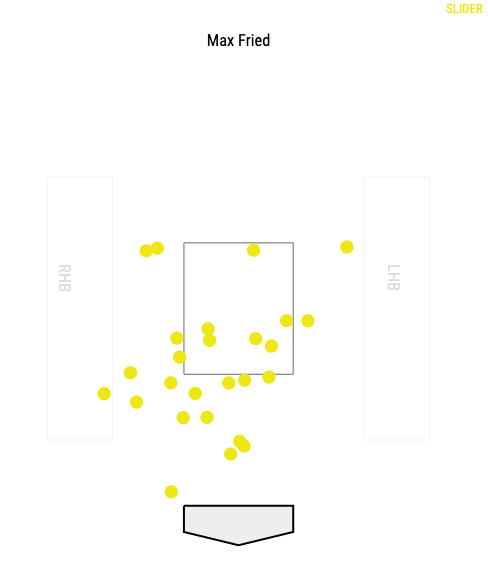
Accordingly, Fried generated positive pVALs on his slider in three of those four starts. It’s a much more consistent putaway pitch. But Fried’s best when both of his breakers are working, keeping batters on their toes, and he can’t rely exclusively on the slider when pitching ahead.
Conclusion
Fried’s got two breaking balls, each of which at least looks better than the single out pitch of many other guys. He’s already there with his slider and just needs to refine his approach or fix the command of his curveball. His fastball could be commanded better as well, but what it lacks can be masked with improvements to his curveball.
As he gets older and sees more game action, I’ll bet that his command improves. And with a little more luck, Fried’s season could have looked remarkably different. I like to bet on the stuff, and with two swing-and-miss pitches and elite contact management, the sky’s the limit for Fried. In sum, I’m looking forward to an even better version of him entering 2020.
Photo by David J. Griffin/Icon Sportswire

One of the most concise, informative, and straightforward Going Deep articles I’ve read. Dope stuff, Dan
Thanks Jordon! Really appreciate the kind feedback
Thank you for the great article! My rotation is pretty solid but I’m looking for a back end guy and am wondering if fried as a dynasty asset would be a better fit over guys like Musgrove or Caleb Smith. I have a rotation including already Verlander, castillo, Corbin, Snell, Flaherty, eduardo rodriguez, hendricks, kluber, and prospects Liberatore and Josiah Gray.
I like him more than Musgrove, and even Smith in dynasty given Smith’s deceptively old. Glad you enjoyed the read!
For someone who doesn’t like to write about pitchers you do a pretty great job of writing about pitchers.
Thanks Ryan!